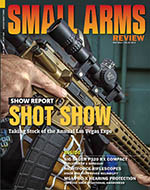Machine Gun Memorabilia: V22N5
By Robert G. Segel
Muzzle Blast magazine. Vol. 1, No. 1, September 1940 is The Regimental Journal of the 2/2nd Machine Gun Battalion. Note the center graphic of “Muzzle Blast” is a front-on view of a Vickers machine gun water jacket with the armored muzzle cone of the gun in black. Formed in mid-1940 in Sydney with volunteers from Queensland and New South Wales. The unit was part of the Australian 9th Division and operated in the Middle East from early 1941 to early 1943 seeing action against German and Italian forces in the First and Second Battles of El Alamein. They then undertook garrison duties in Syria. The 2?/?2nd returned to Australia to then fight several bitter campaigns against the Japanese until the end of the war. The unit was disbanded in 1946. The journal was printed by the 2/2nd headquarters each month detailing the life and activities of the battalion.
British Guards Machine Gun Battalion (1916–1918) officer private purchase cap badge. Center voided with inserted red disc enamel backing. The badge represents a star with the five points being bullets. Between each bullet is the insignia of each of the 5 regiments of the foot guards: the rose (Coldstream Guards), shamrock (Irish Guards), leek (Welsh Guards), thistle (Scots Guards) and grenade (Grenadier Guards). The monogram “GMG” and “1916” are in the center. Two lugs to the rear. This badge of the Guards Machine Gun Battalion changed in May 1918 to embrace the dismounted Household cavalrymen. The new unit was designated the Guards Machine Gun Regiment.
World War II Imperial Japanese Army commemorative lacquered (Urushi) sake cup tray (Obon) given as an award for proficiency in the use of the heavy machine gun. To the center is the machine gun proficiency badge of crossed Taisho 3 heavy machine guns against a flower blossom underneath the army and national Japanese crossed flags. Kanji on the left side bottom reads “Hohei Dai 22 Rentai (22nd Infantry Regiment). This unit was based in Matuyama, Uamagata City, Yamagata Prefecture, the rectangular cartouche is the character “shin” also used sometimes for “makato” which means “sincere, genuine” and is also the name of a branch of one of the main Japanese Buddhists sects, “True Pure Lane.” It could also be a family or given name so the significance in this context in unclear. The tray measures approximately 9x9 inches.
Highly detailed pewter desk sculpture of 20mm Oerlikon anti-aircraft machine gun in action by U.S. Navy personnel depicted during the attack on Pearl Harbor in 1941. The title plaque reads, “U.S. Navy Pearl Harbor 1941.” Made by Chilton Pewter in 1989 for the 1991 50th anniversary of the attack. Signed by the artist (David) “La Rocca.” #219 of a limited edition of 1,941. Mounted on a wood base 5½x7 inches. Approximately 6 inches high.
German regimental stein. 0.5 liter stoneware stein marked “Kriegsweighnacht 1941 4. (M.G.) Komp. Inf. Ers. Batl. 483 Commercy Frankreich (War Christmas 1941, 4th (Machine Gun) Company, Reserve Infantry Battalion 483 Commercy, France). A rare German souvenir from occupied France in World War II. Commercy is situated in the Meuse, Lorraine region in Northeast France and was in the Northern Zone of occupation by Nazi Germany throughout the war.
Boer War era (1899–1902) South African slouch hat badge. Officer’s cut-out silver hat badge from an African-raised Maxim machine gun unit that was part of the British Royal Artillery. Mounted on an original red wool swatch, the unit’s insignia extolled its fast moving capabilities with the Maxim machine gun. Two lugs to rear.
This article first appeared in Small Arms Review V22N5 (May 2018) |
| SUBSCRIBER COMMENT AREA |
Comments have not been generated for this article.









